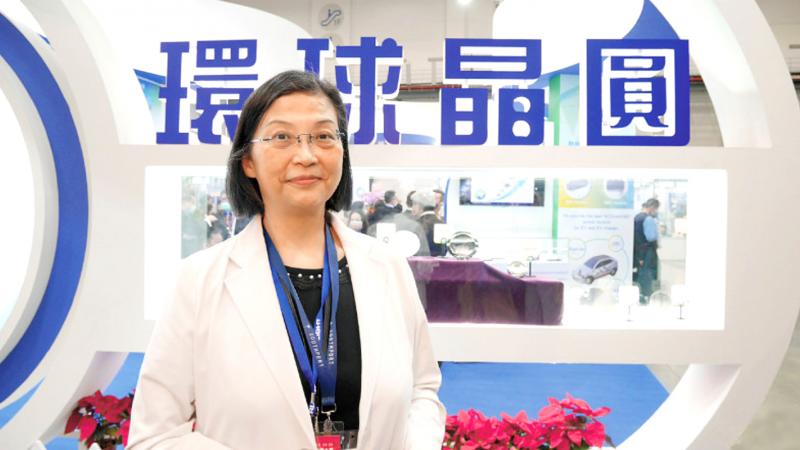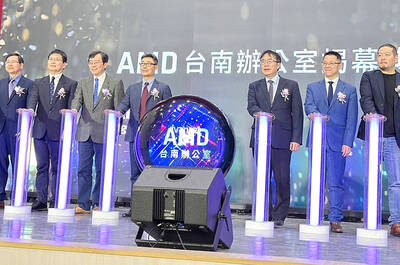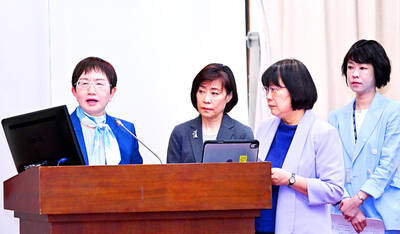GlobalWafers Co (環球晶圓) yesterday unveiled a new capacity expansion plan worth NT$100 billion (US$3.59 billion) as part of its effort to boost capacity and satisfy strong customer demand after its takeover of Germany’s Siltronic AG failed last week.
The world’s third-largest silicon wafer supplier expects the expansion plan to support its revenue growth over the next few years.
This year, revenue could grow by a double-digit percentage on an annual basis as raw wafer demand remains “quite good,” even with some special wafers in short supply, GlobalWafers said.

Photo: Fang Wei-jie, Taipei Times
“While the failed completion of our offer for Siltronic is disappointing, we have pursued a dual-track strategy from the beginning of the tender offer,” GlobalWafers chairwoman and CEO Doris Hsu (徐秀蘭) said during a teleconference yesterday. “I am excited that we can now consider a broad range of options to advance technological development and enhance our capacities.”
The new capacity expansion plan consists of two parts — a new 300mm fab, or green field investments of US$2 billion, and brown field investments of US$1.6 billion on capacity expansion of factories in multiple sites throughout Asia, the US and Europe, Hsu said.
If the Siltronic deal had been given the green light, “our green field investments would be different in scale compared with our previous calculations,” she said.
GlobalWafers dismissed some investors’ concerns about possible oversupply in 2024, saying that new green energy investments worldwide would alleviate supply tightness as raw wafer demand continues to grow on the emergence of new applications.
“The fundamentals did not change at all during the past three months. It is very healthy, although some demand might dip a bit this year,” Hsu said. “Supply continues to be tight.”
“The planned new capacity is mostly for wafers in severe shortage,” she said. “I believe GlobalWafers will continue to be buoyed by the latest capacity expansion.”
Surges in manufacturing costs — in transportation, electricity, raw materials and labor — pose the greatest challenges for the company, Hsu said.
GlobalWafers plans to ramp up production in the new fab in 2024, along with adding capacity from existing factories in the second half of next year.
The company plans to expand capacity for polished wafers, epitaxial wafers, silicon-on-insulator wafers, float-zone wafers, silicon carbide wafers, gallium nitride-on-silicon wafers and other large next-generation products.
The failed Siltronic purchase would not be a barrier to other potential merger and acquisition targets, Hsu said.
However, the company is facing greater challenges in dealmaking, given GlobalWafers’ rising market share amid geopolitical tensions, she said.

TECH CLUSTER: The US company’s new office is in the Shalun Smart Green Energy Science City, a new AI industry base and cybersecurity hub in southern Taiwan US chip designer Advanced Micro Devices Inc (AMD) yesterday launched an office in Tainan’s Gueiren District (歸仁), marking a significant milestone in the development of southern Taiwan’s artificial intelligence (AI) industry, the Tainan City Government said in a statement. AMD Taiwan general manager Vincent Chern (陳民皓) presided over the opening ceremony for the company’s new office at the Shalun Smart Green Energy Science City (沙崙智慧綠能科學城), a new AI industry base and cybersecurity hub in southern Taiwan. Facilities in the new office include an information processing center, and a research and development (R&D) center, the Tainan Economic Development Bureau said. The Ministry

ADVERSARIES: The new list includes 11 entities in China and one in Taiwan, which is a local branch of Chinese cloud computing firm Inspur Group The US added dozens of entities to a trade blacklist on Tuesday, the US Department of Commerce said, in part to disrupt Beijing’s artificial intelligence (AI) and advanced computing capabilities. The action affects 80 entities from countries including China, the United Arab Emirates and Iran, with the commerce department citing their “activities contrary to US national security and foreign policy.” Those added to the “entity list” are restricted from obtaining US items and technologies without government authorization. “We will not allow adversaries to exploit American technology to bolster their own militaries and threaten American lives,” US Secretary of Commerce Howard Lutnick said. The entities

Minister of Finance Chuang Tsui-yun (莊翠雲) yesterday told lawmakers that she “would not speculate,” but a “response plan” has been prepared in case Taiwan is targeted by US President Donald Trump’s reciprocal tariffs, which are to be announced on Wednesday next week. The Trump administration, including US Secretary of the Treasury Scott Bessent, has said that much of the proposed reciprocal tariffs would focus on the 15 countries that have the highest trade surpluses with the US. Bessent has referred to those countries as the “dirty 15,” but has not named them. Last year, Taiwan’s US$73.9 billion trade surplus with the US

The Taipei International Cycle Show (Taipei Cycle) yesterday opened at the Taipei Nangang Exhibition Center, with the event’s organizer expecting a steady recovery in the industry this year following a tough last year. This year, 980 companies from 35 countries are participating in the annual bicycle trade show, showcasing technological breakthroughs and market development trends of the bicycle industry at 3,600 booths, the Taiwan External Trade Development Council (TAITRA, 外貿協會) said in a statement. Under the theme “Ride the Revolution,” the exhibition has attracted more than 3,500 international buyers from 80 countries to preregister for the four-day event, which is expected to